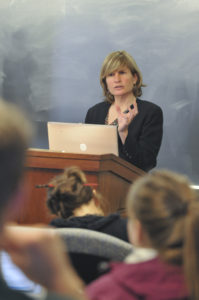Category Archives: Constitutional Law
Oct 26, 2018 Helen NortonConstitutional Law
In Habeas Corpus in Wartime: From the Tower of London to Guantanamo Bay, Amanda Tyler undertakes “to lay out as comprehensively as possible the full story of the legal and political history of the constitutional privilege of the writ of habeas corpus.” She does so with care and style.
In excavating what she calls the “forgotten” Anglo-American legal history of the writ of habeas corpus, Tyler begins, of course, at the beginning, in seventeenth-century England. Among the products of Parliament’s longstanding battle for power with the crown, the original Habeas Corpus Act of 1679 provided that a person who could claim the protection of English law could be detained—that is, imprisoned by the king and his ministers—only through timely criminal prosecution and conviction. Absent timely prosecution, the Act required the prisoner’s discharge. Period. Continue reading "Excavating the Forgotten Suspension Clause"
Sep 21, 2018 Charles Shanor & Amanda ShanorConstitutional Law
Daniel J. Hemel & Eric A. Posner,
Presidential Obstruction of Justice, 106
Cal. L. Rev. __ (forthcoming 2018), available at
SSRN.
Full-length articles on current newsworthy issues are a difficult genre. Special praise, therefore, goes to legal scholars who thoroughly explore a constitutional question on a hot-button issue not only in depth and in a timely fashion, but with insights that exceed the present moment. Dan Hemel and Eric Posner have made just such a contribution with Presidential Obstruction of Justice.
“Can a president be held criminally liable for obstruction of justice?” they ask. (P. 1.) This question has taken on greater urgency in the wake of President Trump’s firing of FBI director James Comey and the continuing investigation by special counsel Robert Mueller into Russian efforts to interfere with the 2016 presidential election and possible collusion between Russia and the Trump campaign. Continue reading "The Law of Obstruction as a Check on Presidential Power"
Aug 9, 2018 Rebecca ZietlowConstitutional Law
Cortney Lollar,
Criminalizing (Poor) Fatherhood, 70
Ala. L. Rev. __ (forthcoming 2018), available at
SSRN.
In the 1980s and 1990s, many scholars and advocates debated the best way to reform our country’s welfare system. During those debates, feminists called for increased enforcement of child support orders against “deadbeat dads.” Congress enacted the 1996 welfare reform act known as the “Personal Responsibility Act” at the same time as it promulgated “war on crime” measures that increased federal penalties for drug-related crimes. Twenty years later, our country is experiencing both a rising gap between the rich and poor and mass incarceration of men of color. Many scholars have discussed the problem of mass incarceration, but there is far too little scholarship on the experience of poor people affected by welfare reforms.
Cortney Lollar’s Criminalizing (Poor) Fatherhood shines a welcome spotlight on the role that law plays in increasing the misery of the poor. In this well-written and well-reasoned article inspired by Lollar’s experience as a public defender, she shows how the confluence of welfare reform and criminal-enforcement measures result in state child support systems that jail non-custodial fathers who cannot afford to pay their child support. Lollar uses feminist analysis to demonstrate how an approach once advocated by feminists actually perpetuates stereotypes about fathers as providers and undermines their relationship with their children, without aiding the mothers who the reforms were supposed to help. Criminalizing (Poor) Fatherhood is a must read for anyone interested in how our criminal justice system perpetuates racial, class, and gender inequality in our society. Continue reading "Criminal Fines and the New Debt Peonage for Poor Fathers"
Jul 19, 2018 Ilya SominConstitutional Law
- Glenn Reynolds, Splitsylvania: State Secession and What to do About it?, available at SSRN.
- Richard Schragger, The Attack on American Cities, 96 Tex. L. Rev. 1163 (2018).
Recent years have seen extensive focus on legal and political conflicts between states and the federal government. Dissenting states seek greater autonomy from federal dictates. Ongoing legal battles over Obamacare and sanctuary cities are just the latest examples of this phenomenon. But we have also seen a lesser well-known trend of conflict between states and local governments. Two new articles, by prominent legal scholars on opposite sides of the political spectrum contend that local governments should have greater autonomy from states. They make a solid case that could be even stronger if each side were more able to acknowledge the concerns of the other.
There is a long history of academic analysis of state-local relations, and scholars such as Yale Law School Dean Heather Gerken have previously made a case for increasing local autonomy. But these new articles related this longstanding topic to recent political controversies—and to our world of severe political polarization, where the conflicts between opposing parties and ideologies are more virulent than they have been for some time. Continue reading "Should Local Governments Have Greater Autonomy from State Governments?"
May 16, 2018 Paul HorwitzConstitutional Law
Are we all still “Legal Realists now?” So it is often assumed. But there are reasons to wonder. Today, it seems, many legal scholars are private Legal Realists only. Their public writing—whether scholarship, public commentary, or legal advocacy—shows few traces of Realism. They are writing to persuade judges or the general public. That counsels against admitting their arguments are malleable and have as much to do with external factors as the “internal” practice of law. To persuade this audience without causing resistance or cynicism, they cannot put all their cards on the table. Is that concealment Legal Realism, or something else—perhaps bad faith?
This question is especially relevant in the Age of Trump. Many legal scholars today are engaged in what Twitter calls #Resistance to the Trump presidency. They see an urgent need to convince judges to counter Trump’s actions. That includes a willingness to urge judges to stretch or reshape existing law. Any Legal Realist understands that this kind of stretching is possible, if not inevitable. They know that judges work with plastic materials and that the springs of their decisions are both “external” and “internal” to the law. Given the perceived urgency of “resistance” to the administration, will scholar-advocates openly acknowledge all this, at the risk of scaring off judges or alienating the public? Or will they keep such thoughts to themselves, insisting publicly that they only seek loyal interpretation and enforcement of “the law?” Continue reading "#Resistance, with Candor"
Apr 19, 2018 Mark KendeConstitutional Law
David Landau,
Legal Pragmatism and Comparative Constitutional Law, in
Elgar Handbook on Comparative Constitutional Theory (forthcoming 2018), available at
SSRN.
Law is a practical field. It resolves concrete disputes. Constitutional law, however, is often thought of as more theoretical than practical. For example, a common current debate in constitutional interpretation is between originalism and living constitutionalism. Both have been advocated and criticized to death. Thus, Thomas Colby and Peter Smith have argued that originalism does not consist of one overarching theory, and that it leaves many questions unanswered. Self-proclaimed originalists disagree on some major issues and acknowledge that courts must often “construct” the right answers. But William van Alstyne has emphasized that living constitutionalists also have “clashing visions.”
It is therefore a breath of fresh air to read David Landau’s forthcoming book chapter, “Legal Pragmatism and Comparative Constitutional Law.” Eschewing these sorts of rehearsed debates between theories that each contain their own brand of formalism, Landau argues that legal pragmatism is an especially useful approach to interpreting the United States Constitution. It requires judges to acknowledge the indeterminacy of constitutional interpretation, to appreciate the importance of focusing on the detailed factual, empirical, and other contextual elements of the constitutional issues presented, and to achieve the best result possible using the toolkit provided by the law, and other “eclectic” criteria. Landau also shows that pragmatism is useful in comparative constitutional law, rather than seeing it as a uniquely American approach. Continue reading "Pragmatist Constitutionalism in Comparative Perspective"
Mar 8, 2018 Pat GudridgeConstitutional Law
Professor Whitman – without doubt a leader in the field of comparative law – manifestly wishes he hadn’t learned what he’s learned:
Awful as it may be to contemplate, but the reality is that the Nazis took a sustained, significant, and sometimes even eager interest in the American example in race law. … In fact, … it was the most radical Nazis who pushed most energetically for the exploitation of American models. Nazi references to American law were neither few nor fleeting…. Nor, importantly, was it only, or even primarily, the Jim Crow South that attracted Nazi lawyers. … Their America was not just the South, it was a racist America writ much larger. (Pp. 4-5.)
More concretely:
American immigration and naturalization laws, … culminating in the Immigration Act of 1924, conditioned entry into the United States on race-based tables of “national origins.” It was America’s race-based immigration law that Hitler praised in Mein Kampf … and leading Nazi legal thinkers did the same after him, repeatedly and volubly. The United States also stood at the forefront in the creation of forms of de jour and de facto second-class citizenships for blacks, Filipinos, Chinese, and others; this too was was of great interest to the Nazis, engaged as they were in creating their own forms of second-class citizenship for Germany’s Jews. … America was a beacon of anti-miscegenation law, with thirty different state regimes – many of them outside the South, and all of them … carefully studied, catalogued, and debated by Nazi lawyers. There were no other models for miscegenation legislation that the Nazis could find in the world…. (P. 12.)
“None of this is entirely easy to talk about.” (P. 14.) Continue reading "Alabama Song? Lotte Lenya? No. Adolph Hitler!"
Feb 8, 2018 Sarah Barringer GordonConstitutional Law
Most likely, Tisa Wenger’s new book Religious Freedom: The Contested History of an American Ideal is not on many law professors’ reading lists. But for anyone who is interested in issues of church and state, race, and American empire, it should be. Wenger has uncovered a powerful collection of movements, legal claims, and government interference in religious life in the early twentieth century. Many of us have either never heard of them, or have not understood how crucial they were to religion’s role in public policy and (occasionally) resistance to government power. This is not a book written by a legal expert: the terms “disestablishment” and “free exercise” don’t appear here. But it is full of constitutional claims and legal conflict, as well as a careful examination of the incentives for invoking religious freedom.
Religious Freedom is in some ways a continuation of Wenger’s first book. In We Have a Religion: The 1920s Pueblo Indian Dance Controversy and American Religious Freedom, Wenger argued that Pueblo Indians successfully deployed the language of religious freedom in the 1920s to protect their dances from white interference. In the process, Wenger maintained, they subtly changed how they understood their own practice, buying into a division between what counts as religious and what is secular. Continue reading "The Problem with Religious Freedom"
Dec 21, 2017 Michael B. CoenenConstitutional Law
Constitutional debates about gerrymandering often start from the premise that redistricting bodies may pursue overtly partisan goals. The Court’s fractured decision in Vieth v. Jubelirer offers support for this idea: Justice Scalia’s plurality opinion characterized “partisan districting” as a “lawful and common practice,” conceding only that an “excessive injection of politics is unlawful.” Justice Kennedy’s concurrence in the judgment similarly noted that “[a] determination that a gerrymander violates the law must rest on something more than the conclusion that political classifications were applied” and that any workable test for evaluating a partisan gerrymander must be capable of “measuring the particular burden a given partisan classification imposes on representational rights.” Even Justices Souter and Ginsburg, though rejecting the outcome in Vieth, were willing to concede that “some intent to gain political advantage is inescapable whenever political bodies devise a district plan” and that “the issue is one of how much is too much.” It is therefore not surprising that much of the post-Vieth commentary and case law has taken this point for granted: to the extent there might be a “judicially manageable standard” for adjudicating partisan gerrymandering claims, that standard must be capable of distinguishing between the merely partisan gerrymander (which the Constitution permits) and the excessively partisan gerrymander (which the Constitution condemns). Such a standard, in other words, must answer the question of “how much is too much.”
In their recent, respective articles, Professors Michael Kang and Justin Levitt resist this framing of the inquiry. Rather than attempt to ask “how much” partisanship is “too much” partisanship, each author would instead ask whether a particular type of partisanship has infected the redistricting process (K. 354; L. 2). Thus, as Levitt puts it, the law of partisan gerrymandering should make it clear that “public action undertaken in order to disfavor citizens because of their party affiliation is not merely a species of normal politics, but impermissible in any degree” (L. 37). And Kang similarly maintains that courts ought expressly to “identify partisan purpose as constitutionally illegitimate” (K. 373). Both authors thus propose inquiries that would treat the presence of forbidden partisan intent as an independently sufficient basis for invalidating a legislative redistricting scheme. Continue reading "Partisan Intent"
Dec 6, 2017 Cary C. FranklinConstitutional Law
The article that made me think hardest about American constitutional law this year was not a work of legal scholarship. It was historian Rick Perlstein’s meditation on the making of modern American conservatism.
Perlstein begins his article by describing the “rough consensus” among historians about how the right became the dominant political force in American politics in the second half of the twentieth century. The story starts in 1955, when William F. Buckley Jr. founded the National Review to combat the decades-long marginalization of political conservatism. Buckley banished John Birchers, anti-Semites, and fanatical Ayn Randians and “fused the diverse schools of conservative thinking—traditionalist philosophers, militant anti-Communists, libertarian economists—into a coherent ideology.” Fueled by support from white suburban voters, the new political conservatives thrived. Crucial to their success—or so the story goes—was their denouncement of the “political surrealism of the paranoid fringe.” Particularly in the South, new movement conservatives sublimated the “frenetic, violent anxieties” aroused by race, and spoke instead of “stable housing values,” “quality local education,” and “colorblind constitutionalism.” Simply put, modern conservatism became a dominant force by eschewing what Richard Hofstadter called “the paranoid style in American politics.” Continue reading "The Paranoid “Fringe” in American Politics "
















